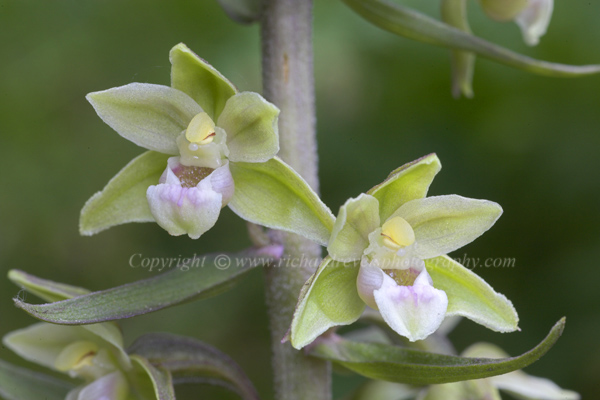Bedfordshire has recent records of three Epipactis helleborines to look out for and one other that used to occur relatively recently.
Chris`s flora of the county records Marsh Helleborine as having been long considered extinct in the county but appeared in a wet flush in the sunken path on Bison Hill, Whipsnade in 1966 and was seen for about 6 years.
It would be worth looking here again but also in the wet areas of our chalk or limestone quarries. I fancy Sundon and Houghton Regis chalk pits as likely locations..but any regularly wet flushed area, however small on chalky soils could hold this species.
The Violet Helleborine is just coming out with a record already received for Kings Wood, Houghton Conquest. Keep an eye out for this attractive plant in the Studham/Whipsnade area. Even a trip to the Zoo could reveal the purple tinged stems beneath trees on the top of the chalk scarp! look out for elephants though.
But be prepared to see this plant in even small woods anywhere in the county. It can tolerate deep shade.
Here are two of Richard Revels` photos of Violet Helleborine.
Violet Helleborine
The Broad-leaved Helleborine is more likely to be encountered and the most recent records are from woodlands on the Greensand ridge, north of the ridge and in the north west of the county. It does also occur in the south and could be found in almost any woodland or even on grassland that may have been recently scrubby, with colonies needing recording at Fancott wood and Felmersham nature reserves. Look for it at ride and path edges
Broad-leaved Helleborine. Photo Richard Revels. Note broad leaves usually spirally arranged on stem rather than two rows opposite each other. Lower leaves as broad as is wide.
Broad-leaved Helleborine. Photo Richard Revells. Flowers may vary in colour with some almost wine red others green.
The Green-flowered Helleborine is a rare orchid in Bedfordshire but nevertheless worth looking out for.
We have records submitted already for the Barton cutting on the A6 in traditional areas, but the new woodland associated with the cutting may hold this species as it has some reputation of appearing in new locations and any woodland should be looked at in the Barton to Pegsdon area.
The "Barton Caves" area on Old Road Barton being one old location.

Grren-flowered Helleborine. Photo Richard Revels. Was also known as Pendulous- flowered Helleborine the flowers dangling on large pods. The flowers are frequently not as open as this and are self -pollinated.

Green-flowered Helleborine. Photo Richard Revels. Ovaries hairless

Green-flowered Helleborine with irregular clumps of cilia along leaf margin compared with an even fringe in other Helleborines.
A hand lens is useful here!
Good luck with your searches and i look forward to your records.













